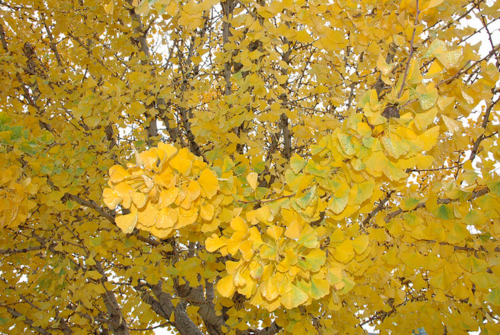
Gingko (Gingko biloba) eventually grows into a large tree, also known as "Maidenhair tree". It is a deciduous tree with a very ancient heritage as the oldest tree on Earth. It is extremely hardy, long-lived.[1]
It originates from China.
Gingko can tolerate drought, heat, air pollution and salt.[1]
Description[edit | edit source]
This plant has light-green to emerald coloured leaves. The leaves form in a fan shape. In autumn, the leaves turn a rich yellow.
The female tree has seeds and fruit shaped like plums with a fleshy pulp. As it ripens, it smells foul to the human sense of smell.
The tree eventually grows to around 40 to 70 feet in height.[1]
Growing gingko[edit | edit source]
The gingko plant can be grown in a container for many years.
It is important to choose a male plant if you're planning on planting the gingko in the garden to grow it to full tree size. Female trees produce fruits that smell bad and create a great deal of mess. As large trees, they are very costly to remove at this stage. Choose cultivated varieties.
Choose a site with full sun, although the plant can tolerate shade. It will grow in many soil types but not wet soil.[1]
Uses for gingko[edit | edit source]
Grow as an ornamental tree; it is often grown as a street tree.
Caution[edit | edit source]
The fruit is messy; the female fruit is also foul smelling.[1]
The juice of the seed pulp can irritate the skin, and if eaten can irritate the lips, mouth, throat and cause stomach pain, nausea and diarrhea.[1] The plant contains an alkyl phenol and gingkolic acid. The seed can only be eaten after removing the outer pulp, washing it and boiling or roasting it.[1]
The fruit is toxic if eaten in large quantities, while skin irritation is of short duration.[1]